El Calafate is a small town that acts as a gateway to the Glaciers National Park where the famous Perito Moreno Glacier awaits tourists. An interesting sign at the town entrance
Jason at a sign that displays the different birds that can be found in the wetlands here in El Calafate.The unspectacular entry to the Glaciers National Park to get to the Perito Moreno Glacier. Entry was 12,000 ARS (about $13) per person, a huge increase from last year's price. Thank you inflation. The glacier viewpoints are still another 30 kms. beyond the entrance here.
We found this wonderful hiding spot a few minutes away from the entrance to the park. Off the main road, down a gravel road and off on a dirt two-track to this grove of trees that gave us protection from the wind as well. We were joined by a couple of other vehicles for the night as well.
Our view from our grove of trees. The park and glacier are up that valley.
Across the gravel road is wetlands where we saw this pair of black-necked swans.
The campervan in front of us was one of our neighbors in the grove of trees overnight. We're now driving to the Perito Moreno glacier in the park.
Our first glimpse of the face of the glacier.
Extensive metal stairs and walkways lead down to several viewing platforms across from the face of the glacier.
So many crevasses in the ice near this end of the glacier. Such pretty blues.
The glacier won't fit into the view of the camera. This is the one end as we start down the walkway.
We sensed the drop in temp right away and turned around and got into our winter gear for the day. Jason in front of the other side of the glacier.
You can see the cold fog hanging over the ice of the glacier. The dark stripes in the ice is old sediment layers--dirt. The dark area in front of the ice is rock in the canal. A few years ago, there was an ice bridge across this narrow canal and an ice tunnel that finally collapsed. There still isn't much room for the meltwater from the left lake to get through this narrow canal to the other lake.
There are chunks of ice that have calved off and are in the water near the face of the glacier.
The wind, rain, and splashing water makes for some interesting shapes and textures in the ice bergs.
The pretty blues are everywhere in the ice.
A low grumble, a loud CRAAACK, and a whoosh as the ice chunks calved off and fell onto the water. The cracking sound was heard for both the breaking of the ice and the slapping of the chunk hitting the water.
Odd shapes in aqua floated until they got too heavy and either rolled over or broke off into smaller chunks.
The wind came up and blew the smaller pieces all together. They bunched up and blocked much of the water movement in the Canal de losTempanos, the narrow waterway between the face of the glacier and the mainland where we stood.
In the deeper crevasses, the blue actually looked violet.
Some odd shapes and markings on the bergs in the canal
Lots of ice spikes.
Not what we expected at the edge of a glacier.
I had on four layers of shirt, wind shirt, sweatshirt, and winter coat. Also, my neck warmer, hat, hood, and earmuffs, plus gloves. It was cold down near that much ice!
This glacier is beautiful. And this was on another overcast day.
As the clouds/fog lifted a bit, you could see way up the glacier. This is part of an ice sheet that is over 230 miles long!
Extensive weathering on the ice bergs left this one looking like Swiss cheese.
This one just toppled over.
We watched a huge chunk calve off right in the middle here. Saw a few of them fall while we were there. Caught one on video, but it's too big of a file to post here.
Looking across the top of the glacier, Perito Moreno.
The compressed ice turns the deep, clear aqua under the pressure. This part of the glacier is right up on the rocks in the canal just below us. They say the glacier moves about 6-10 feet a day!
The wind was blowing towards this part of the glacier and all the bergy bits were pushed up against the face.
A long view of the glacier from up high on the walkway.
This side of the glacier didn't seem to have as many calvings as the part we watched. We saw three boats full of tourists out in the lakes, but we were closer to the ice than they could get, so we didn't go on the boats.
Looking across the face of the glacier. The deep aqua was about the middle.
Black dirt and rocks sandwich the deep blue of the compressed ice. Awesome.
The clouds moved in again and blew snow on us in the afternoon.
I couldn't get enough of this pretty ice. It's only about 200 feet high here at the water, but it is closer to 600 feet deep farther back,A late afternoon selfie over my head.
How did chunks of ice get on top of an ice berg?
Close up of some precariously perched ice bergs.
So many different shapes and sizes of blue ice bergs.
This area was cracking and breaking up with several chunks falling into the canal.
As the wind and water fought with each other, they pushed the bergs around and the scenery changed frequently.
Some cracks and whooshes were from ice escaping from underneath the glacier.
The ice reminded us of Aqua Velva and/or the fake ice you can get in cold packs.
Bergs of blue.
Karen keeping warm down next to the ice at Perito Moreno Glacier in Patagonia.
That grey cloud behind Karen is the snow coming!
A loud crack and a tumble of ice grabbed my attention.
You can see how the bergy chunks have now been blown back towards the ice.The sediment lines make interesting designs in black on the blue and white.
Snow's a comin', time to leave this cold place. It was awesome!
Argentina still claims ownership of the Malvinas Islands, aka the Falkland Islands that the UK claims are theirs.These flowering bushy trees are getting red bottlebrush blooms and are starting to paint the hillsides red. Looks like autumn but it's just getting into spring here.
The dead grey wood from tree stumps looked nice against the green fields and the blue of the water and sky. You don't see many fields of dead trees in Patagonia.
A calf bawling for its mama. It's on the wrong side of the fence. Lots of animals end up on the road side of the fences around here and signs warn of loose animals. Cows, sheep, guanaco, and nandu were all seen roaming along the verges of the roads. Nobody drives at night on these roads.
We headed down a dirt/gravel road to a free park campground on the other side of a lake from the glacier. We were stopped by this section of flooded road. We don't have 4x4 and the mud in the tracks looked too gooey to be safe for our heavy van. We decided not to risk it and turned around and went back to our place in the grove of trees.



























































No comments:
Post a Comment